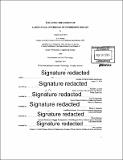Locating the source of large scale outbreaks of foodborne disease
Author(s)
Horn, Abigail Lauren
DownloadFull printable version (40.04Mb)
Other Contributors
Massachusetts Institute of Technology. Engineering Systems Division.
Advisor
Richard C. Larson and Stan N. Finkelstein.
Terms of use
Metadata
Show full item recordAbstract
Foodborne illness outbreaks impose enormous health and economic burdens in the US. Identifying the origin of the contaminated food causing an outbreak is a challenging problem due to the complexity of the food supply and the absence of coherent labeling and distribution records. Current investigative methods are slow, resource intensive, and the overwhelming majority of investigations are unsuccessful in identifying the location source of an outbreak. New tools and approaches that take advantage of modern data and analytical techniques are needed to more quickly identify outbreak origins and prioritize response efforts. The practical objective of this work is to improve the food safety regulator's ability to efficiently locate the source of an outbreak while contamination-caused illnesses are occurring, thereby resolving investigations earlier and averting potential illnesses. This thesis develops new methods that leverage currently unutilized or underutilized sources of information to identify the location source of an outbreak. A novel, network-theoretic approach to source detection is developed that (1) immediately identifies all feasible source locations, (2) ranks the feasible locations by the likelihood that each one is the true source, and (3) develops a decision model for guiding investigators to implement effective interventions. The approach functions on food system network data, reported cases of illness at specific times and locations, and a prior probability function over likely sources. The methodology is the first to be designed specifically for tracing back outbreaks on food distribution networks. A Monte Carlo simulation environment was developed to evaluate traceback performance and robustness across a wide range of network structures and outbreak scenarios. When compared against existing traceback methods, both those currently in practice and those in academic literature, this methodology demonstrates significant improvements in accuracy, efficiency, and speed. Specific results suggest the approach can provide substantial benefits to the investigation process by identifying the source early enough in an outbreak's progression that a substantial fraction of cases of illness can be averted. These computational results serve as a powerful first step towards validating the accuracy and applicability of the approach. The immediate next step will be to demonstrate accuracy when applied to real food distribution networks. While acquiring representative network data for this purpose presents significant practical challenges, an additional contribution of this work is the identification of a representative network model that can be integrated with the source identification methodology, forming a holistic traceback framework.
Description
Thesis: Ph. D. in Engineering Systems, Massachusetts Institute of Technology, School of Engineering, Institute for Data, Systems, and Society, 2016. Page 136 blank. Cataloged from PDF version of thesis. Includes bibliographical references (pages 129-135).
Date issued
2016Department
Massachusetts Institute of Technology. Engineering Systems Division; Massachusetts Institute of Technology. Institute for Data, Systems, and SocietyPublisher
Massachusetts Institute of Technology
Keywords
Institute for Data, Systems, and Society., Engineering Systems Division.